
Lens hood can prevent unwanted light rays from entering the lens and hence reduce lens glare and ghost images. See On-Camera Lens Overview for some details and examples. Unfortunately, none of these five lens converters comes with a lens hood, and, except for TC-E2 and TC-E3ED, there is no Nikon-brand lens hoods available. We certainly do not expect to use a lens hood on FC-E8 Fisheye lens. Nikon recommends HN-23 or HN-24 for TC-E2 and HN-20 for TC-E3ED. For the on-camera lens and the two wide angle converters, no suggestions are made. Fortunately, lens hoods are widely available. Since thread sizes are usually larger than or equal to 49mm, the on-camera lens and WC-E24 cannot be fit with a lens hood directly.
| Lens | Nikon's Recommendation |
| FC-E8 Fisheye | None |
| WC-E24 Wide Angle | None |
| WC-E63 Wide Angle | None |
| TC-E2 Telephoto | HN-23 or HN-24 |
| TC-E3ED | HN-20 |
When choosing a lens hood, thread size is not the only factor. In fact, we need to take angle of view into consideration. For example, if a lens hood made for telephoto lens is mounted on a wide-angle converter, vignetting occurs. In the left figure below, a lens hood for normal or telephoto lens is mounted on a wide angle lens. Since the wide angle lens has a wider angle of view, part of the scene covered by the lens is cut off by the lens hood and vignetting occurs. The right figure below shows a wide angle lens hood mounted on a telephoto lens. In this case, light rays that are not within the angle of view can also reach the lens. This causes lens flare or ghost images, which defeats the purpose of using a lens hood.

Lens hoods can be metal, plastic or rubber. Rubber lens hoods are usually collapsible, and some of them can even be extendible that are capable of covering a wide range of focal lengths. The first image below shows the TC-E2 and a metal hood, while the second and third images show a rubber hood on TC-E3ED, collapsed and extended, respectively. In general, collapsible hoods are easy to carry and require less space. Metal hoods provide a better protection of the lens than rubber ones do.
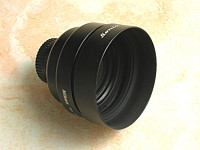
|
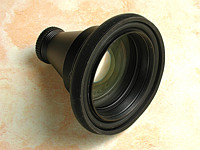
|
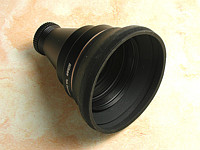
|
| Metal lens hood | Rubber lens hood - collapsed | Rubber lens hood - extended |
| Click on an image to see a larger one | ||
The most commonly seen lens hoods are of the "standard" type for standard to moderate telephoto lens. Some of them also support moderate wide angle lens (e.g., 35mm). There are wide angle lens hoods designed to be used with wide angle lenses, and telephoto hoods for telephoto lenses. Usually, the thread size of a lens hood cannot be used to make a decision. To choose a right type of lens hood, a few sample shots are necessary. More precisely, mount the lens hood on the lens, use step-up rings if necessary, and use LCD monitor to judge if vignetting occurs. For wide angle lens hoods, zoom the on-camera lens all the way out. If shadows appear in four corners, vignetting appears. However, even though you don't see vignetting, it does not mean this particular lens hood does not cause any problem because LCD monitor only covers 97% of the image taken. To better judge if vignetting will occur with a particular lens hood, take some images with brighter area near the corners (so that you can easily spot vignetting) and check the images. For telephoto lens, zoom the on-camera lens in so that no vignetting occurs in your image. Then, mount the lens hoods. If vignetting occurs, this particular lens hood cannot be used with the shortest combined focal length of this telephoto converter. However, if shorter focal lengths are not used frequently, zoom the on-camera lens all the way in to see if vignetting occurs. Choose a lens hood that does not cause vignetting.
There are four mounting mechanisms, namely screw-in, slip-on, snap-on and bayonet. The on-camera lens and all five lens converters do not have any mechanism for bayonet mounting. Moreover, the screw-in lens hoods are the most popular type, and, as a result, most non-brand lens hoods are of this type. Hence, it is likely that you will only use screw-in lens hoods.
The on-camera lens has thread size 28mm. It is unlikely you can find a lens hood of this thread size. But, there is a simple way to get a reasonably good lens hood. If you use various filters, you might carry some step-up rings. Stacking them together would become a lens hood as shown in the left image below. The right image shows that three step-up rings are used, the bottom one being 28-37mm, the middle one 37-46mm and the top one 46-49mm. You certainly can add more step-up rings together to make a deeper lens hood. But, keep in mind that the top ones must be large enough to prevent vignetting. Experiment first before use.
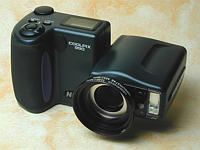
|
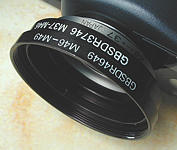
|
| A number of step-up rings can make into a lens hood | |
| Click on an image to see a larger one | |
You can also use step-up ring to mount a lens hood on the on-camera lens. As mentioned earlier, since the smallest thread size of lens hoods is perhaps 49mm, step-up rings that can change 28mm to 49mm are required. In fact, the fewer number of step-up rings the better. The following shows a standard 49mm rubber lens hood mounted on a 990 (left), and the step-up rings used are 28-37mm and 37-49mm. Since this lens hood blocks the flash sensor completely and the internal flash partially, you may not be able to use the internal and/or external flashes.
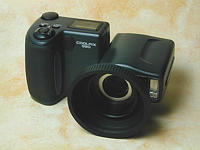
|

|
| Standard rubber lens hood | Step-up rings are required |
| Click on an image to see a larger one | |
For tele converters, use a standard or telephoto lens hood. When use a standard one, select a hood with longer tube to prevent unwanted light rays from entering the lens. So, selecting a lens hood for telephoto converters is quite easy.

|

|
| Metal lens hood for TC-E2 | Rubber lens hood for TC-E3ED |
| Click on an image to see a larger one | |
Finding a lens hood for WC-E63 is easy. Just buy a 72mm thread wide angle hood. The WC-E24 proves to be more troublesome because of its thread size. Since it is unlikely you can find a 48mm wide angle lens hood, at least one step-up ring that brings 48mm to 58mm is required. Then, a 58mm wide angle lens hood can be used. The problem is that the step-up ring could be thick enough to produce vignetting. (Yes, not all step-up rings are created equal. Some of them are thicker than the others. Buy a thin one if you can find one.) Unfortunately, even though you might find a thin 48-58mm step-up ring, some lens hoods may have thick mounting rings which will also create vignetting. The left image below shows WC-E63 with a 72mm wide angle lens hood, and the right one has a 58mm wide angle lens hood mounted on WC-E24 with the help of a 48-58mm step-up ring. The lens hood in the right image below is not good enough because it has a very thick center ring for mounting filters that causes serious vignetting even if a very thin step-up ring is used. Therefore, test before you buy.
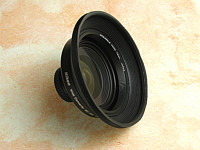
|
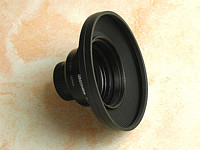
|
| Wide angle lens hood for WC-E63 | Wide angle lens hood for WC-E24 |
| Click on an image to see a larger one | |
There are lens hoods taking the "one-fits-all" concept. This type of lens hoods can cover a range of focal length or angle of view. One such model is Hama's Telematic S Zoom that can cover from 24mm to 210mm. When this lens hood is fully collapsed, it is good for the WC-E63 at 24mm without vignetting. See the images below. When it is extended half way, it covers TC-E2 and TC-E3ED. If this is not enough, the top part of the hood can be folded out to create a deeper tube that should be sufficient for TC-E3ED.
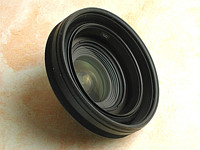
|
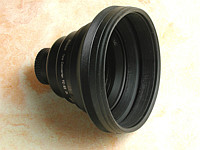
|
|
WC-E63 with Telematic Zoom
|
TC-E2 with Telematic Zoom |

|
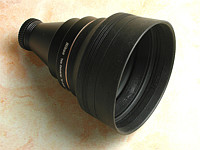
|
|
TC-E3ED Telematic Zoom
|
TC-E3ED with Telematic Zoom fully extended |
| Click on an image to see a larger one | |